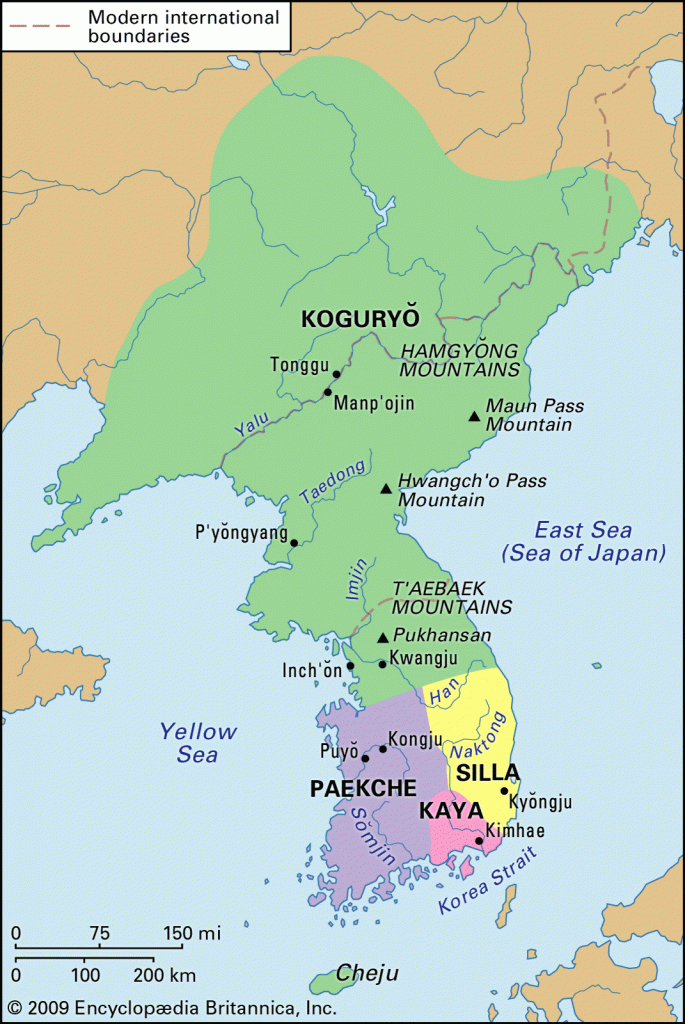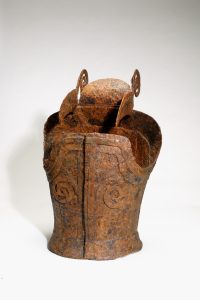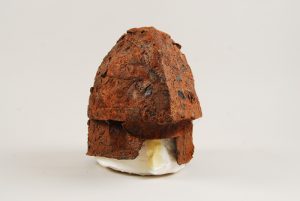Melissa Fitzmaurice
History has not always been written down, nor do written documents always last the decades- or centuries-long span between when they are written to when they are used by historians. When discussing ancient history, textual primary sources are not always readily available. But textual documents are not the only sources useful in understanding the past. Archaeology, and the artifactual findings it results in, are alternative primary sources of the past. Archaeologists and historians can use these archaeological findings as documents about the past. A sword or a simple piece of pottery can lead to knowledge about what life was like, as well as who traded with whom. In Korean history, archaeology is just as important as textual primary sources, especially when certain periods in Korea’s history are lacking in textual documents. Archaeology can help historians understand the relations between the Japanese archipelago and the Korean peninsula, and artifacts can be claimed in an attempt to claim ownership of the past, such as is the case in the between Korea and the People’s Republic of China over the historical site of Goguryeo (Koguryŏ). These two cases appear on opposite ends of the Korean Peninsula, but at it’s core is the dispute over history: questions of what happened in the past, and radical claims made to rewrite history. Archaeology is able to be used in both cases, but the answers archaeology gives still furthers the conflict and allows a biased view of the past.

Gaya’s disputed archaeology
During Korea’s Three Kingdom period, approximately 57 BCE to 668 CE, there was a fourth ancient polity on the Korean peninsula called Gaya.[1] There has been significant controversy over the nature of relations between Gaya and Japan during this period, not only over how strong the connection between the two was, but on the extent of Japan’s hold in the Korean peninsula as well. It is relevant to note that during this time, Japan was commonly referred to as Yamato, but for the purpose of this chapter, we will refer to it as Japan. This debate centers around the existence of Mimana, a territory within Gaya that was ruled by a Japanese official.[2] While on its own this is already a vast and complicated issue, in our case what is worth noting here is how archaeological findings between the Korean Peninsula and Japan can offer light on the connection and relationship these historic states had with each other.
Archaeological artifacts dating to the Three Kingdoms period have been found showing artifacts of both Japanese-style and Korean-style on both sides of the Korean Strait. In particular Korean armor from the 4th century is abundant in Japan, with Gaya being a large producer of iron and iron armor in this period.[3] However the mere appearance of this armor on both sides of the Korean strait does nothing to describe the true relationship between Gaya and Japan; armor alone neither proves nor disproves the theory of conquest being the means by which objects ended up far from their place of manufacture.


In fact, when discussing the existence of Japanese goods found in Korean graves, archaeologist Shin Kyung Cheol “does not see these as evidence of Yamato conquerors, and indeed, the frequencies and nature of the objects do not support a military incursion but are most likely the results of prestige good exchanges between local rulers of Gaya and Yamato”.[4] This distinction is important in the relationship between Gaya and Japan since still there is a debate over the true nature of the relationship between the two, although the archaeological evidence shows that relations between Gaya and Japan were largely founded in trade, not conquest.
Expanding beyond the shared presence of common armor in the context of the Mimana dispute, historical evidence found on either side of the Korean Strait offers a look at how trade developed between the two regions. Besides iron, armor, and pottery, period horse trapping from Korea are found in Japan. These horse trappings are items that are used in the domestication of horses, such as saddles and reins. Though the evidence of horse trappings could be used in evidence of a not-so-peaceful relationship between these two regions, the existence of pottery discourages that thought as it is a sign of domesticity, as well as indicative of the finer things in life. People from southern Korea moved to Japan and brought with them the tunnel kiln, as well as pottery techniques used with it. Pottery that resembled pottery from southern Korean has been found in Japan, dating from 425 to 450 CE.[5] This sharing of technology indicates friendly trade relations, as well as emigration from the Korean Peninsula and into Japan.
The relationship between Japan and Korea is a sensitive matter. It is a question of supposed conquest in the past used to justify later conquest. Archaeological evidence is able to be use by both sides to favor the story they want to tell of the past. These artifacts are interpreted according to biases; the archaeologists and historians can look at the armor and horse trappings seen on both sides of the Korean Strait and insist that the only logical conclusion was Japanese conquest of Korea during the Three Kingdom period. Nationalism and imperialism can cause detrimental effects on how history is seen, and archaeology is subjective to that. Much like the Japanese claim over parts of Korea’s history, the People’s Republic of China has used archaeology in favor of their interpretations of the past.
The case of Goguryeo
This particularly extreme use of archaeology to favor one particular view of the past can be seen when looking at the dispute over the historical heritage of Goguryeo between China and Korea. Goguryeo was the largest and oldest of the Three Kingdoms, residing centrally around the Yalu River in the northern part of the Korean peninsula.[6] Its history is important to Korean heritage (and especially Korean nationalism) as it was one of the three kingdoms that dominated the peninsula for centuries. But in 2002 the People’s Republic of China began the Northeast Project, which claimed that Koguryŏ was a part of Chinese history, not Korea’s; asserting that claim that that the Goguryeo people were of Chinese ethnicity, and therefore not Korean.[7] The Northeast Project intended to erase hundreds of years of Korean history, as well as take an important historical site away from the Korean people in order to further the political goals of the PRC of Chinese dominance in Eastern Asia.
However, this conflict did not simply begin in 2002 with the start of the aforementioned project. After a joint North Korean-Chinese archaeological expedition in the 1960s, both Korea and China filed claims to the World Heritage Committee about archaeological findings in Goguryeo territory. These claims resulted in joint-ownership of these artifacts from Goguryeo , which did nothing to ease the tension between the two countries.[8] All of this, however, does raise the question of why these claims are so important, and the answer points to the construction of modern nationalism, the legitimacy of Korean and Chinese national identity, and ultimately their legitimacy as nation-states.
All that is of course a much larger issue – far too large to properly discuss here – but in short the question of who can lay claim to Goguryeo is related to the question of national identity and legitimacy of the nation’s sovereignty. Historical sites, as well as monuments and other artifacts, are important in establishing a solid national identity.[9] But how much does it matter who actually holds proper claim to archaeological artifacts from a long-defunct state? Quite a lot actually. To both Korea and China, the historical control of this territory holds a huge importance to their society and culture and the attribution of artifacts from Goguryeo to either country solely serves to reinforce which of them can claim it as direct heritage. Therein lies why joint-ownership of the artifacts only causes more friction, since to them, China and Korea cannot both claim ownership of Goguryeo as they both claim its heritage with mutually exclusively theories.
As with written sources, archaeological findings are sometimes used to persuade others into a particular view of history. With the Goguryeo conflict, China and Korea both try to use archaeology to support their claim of Goguryeo. With the controversy surrounding Mimana, Japan could use the vast evidence of similar artifacts found on either side of the Korean Strait to claim the existence of Mimana, as well as the Japanese conquest of Korea during the Three Kingdom period. Archaeology can be used in this way, so, as with all sources, one must be careful to see possible biases in the interpretations of the past. Archaeology offers an alternative source to historical information, as well as provides sources for time periods where there is little or no written history. As you look at artifacts from the past, at pottery and armor and swords, there is something quite human about it. Human beings from hundreds, if not thousands of years ago made these objects, used these objects, and we are able to learn so much about the humanity of the past through them. But biased interpretations of these artifacts can lead to major modern implications about what the past was like, questions of national heritage, and how one artifacts go across the sea.
Bibliography
Ahn, Yonson. “Competing Nationalisms: The Mobilisation of History and Archaeology in the Korea-China Wars over Koguryŏ/Gaogouli.” The Asia-Pacific Journal 4, no. 2 (February 2006): 1-18. https://apjjf.org/-Yonson-Ahn/1837/article.html
Barnes, Gina L. “Archaeological Armor in Korea and Japan: Styles, Technology, and Social Setting.” Journal of East Asian Archaeology. 2, no. 3/4 (2000): 61-95. doi: 10.1163/156852300760222056
Chung, Jae Ho. “China and Northeast Asia: A Complex Equation for ‘Peaceful Rise.’” Politics 27, no. 3 (October 2007): 156–64. doi:10.1111/j.1467-9256.2007.00295.x.
Farris, William Wayne. “Ancient Japan’s Korean Connection.” Korean Studies 20, No. 1 (1996): 1-22. www.jstor.org/stable/23719600.
Seth, Michael J. A Concise History of Korea: From Antiquity to the Present. 2nd ed. Lanham: Rowman & Littlefield, 2016.
- For an overview of the textual history of Gaya, please see the previous chapter. ↵
- Michael J. Seth, A Concise History of Korea: From Antiquity to the Present. 2nd ed. (Lanham: Rowman & Littlefield, 2016), 33. ↵
- Gina L. Barnes, “Archaeological Armor in Korea and Japan: Styles, Technology, and Social Setting,” Journal of East Asian Archaeology 2, no. 3/4 (2000), 61-62. ↵
- Ibid., 82. ↵
- William Wayne Farris, "Ancient Japan's Korean Connection," Korean Studies 20, no. 1 (1996), 10-11. ↵
- Seth, A Concise History of Korea: From Antiquity to the Present, 30. ↵
- Chung, Jae Ho. “China and Northeast Asia: A Complex Equation for ‘Peaceful Rise.’” Politics 27, no. 3 (2007), 160. ↵
- Ahn, Yonson. “Competing Nationalisms: The mobilisation of history and archaeology in the Korea-China wars over Goguryeo/Gaogouli.” The Asia-Pacific Journal 4, no. 2 (2006), 7-8. ↵
- Ibid., 9-10. ↵
